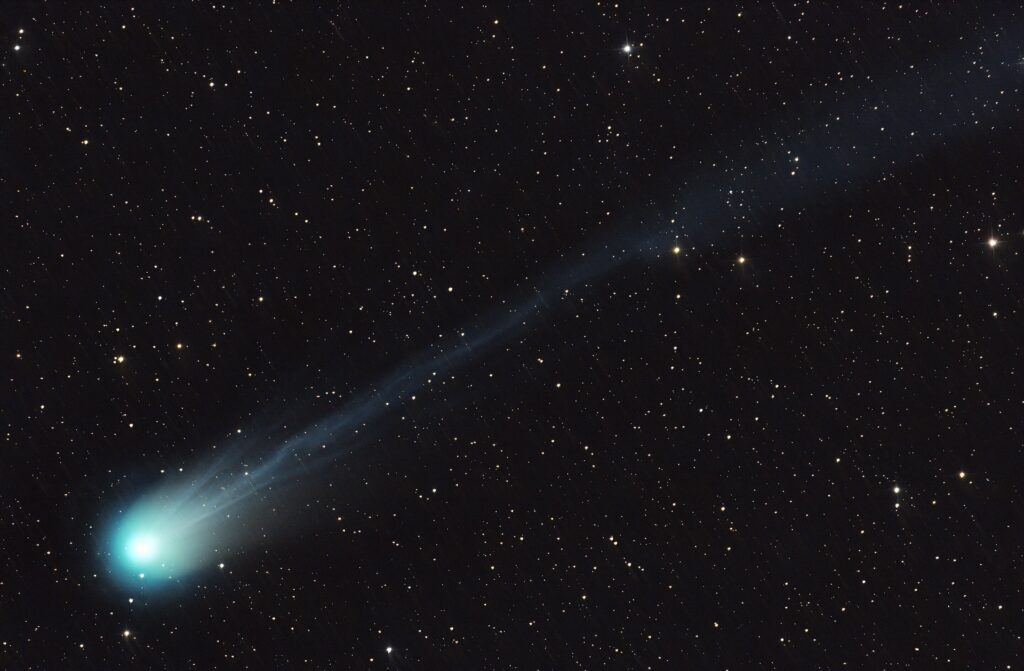astronomy
12P/Pons-Brooks: Witness the ‘Mother of Dragons’ Comet in the Night Sky!
Witness the “Mother of Dragons” comet, Comet 12P/Pons-Brooks, in the Northern Hemisphere’s night sky – a rare celestial spectacle not to be missed!

Astronomical enthusiasts and stargazers have a limited window to behold the captivating spectacle of the “Mother of Dragons” comet, also known as Comet 12P/Pons-Brooks. This celestial wanderer, gracing our skies once every 71 years, is currently making its grand appearance in the Northern Hemisphere.
Discovered in 1812 by French astronomer Jean-Louis Pons and British-American astronomer William Robert, this massive comet, larger than Mount Everest, is a breathtaking amalgamation of dust and ice. Its magnificent green tail, a result of the Sun’s heat interacting with its icy composition, paints a vivid picture across the cosmos.
What sets Comet 12P/Pons-Brooks apart is its classification as a cryovolcanic comet, harboring an icy volcano that releases dust, gases, and ice as it journeys through space. To catch a glimpse of this rare celestial visitor, observers are advised to look towards the western horizon in clear, dark skies post-dusk. While it may be visible to the naked eye, binoculars or a small telescope can enhance the viewing experience, particularly as its brightness can be unpredictable.
The highlight of this cosmic display is anticipated to be on April 21, marking the comet’s brightest phase before gradually fading from view as the days lengthen. Missing this astronomical event means waiting until the summer of 2095 for another chance to witness the “Mother of Dragons” comet in all its splendor. So seize the opportunity while you can, and marvel at the celestial wonder that graces our night sky in this fleeting moment of cosmic convergence.
About 12P/Pons-Brooks
12P/Pons-Brooks is a comet that returns every 71 years. It is one of the brightest periodic comets and can reach an absolute visual magnitude of about 5. The comet was first seen in July 1812 by Jean-Louis Pons at Marseilles Observatory, and again in 1883 by William Robert Brooks. Comets that have an orbital period of 20-200 years are called Halley-type comets. Some ancient records suggest that 12P/Pons-Brooks has appeared before.
The next time the comet passes the sun at its closest point will be on 21 April 2024. It will come the closest to Earth on 2 June 2024, at a distance of 232 million kilometers. During this time, it is expected to shine as bright as a 4.5 magnitude star. The comet’s nucleus is estimated to be around 30 kilometers in diameter, based on the 2020 measurements that were taken assuming it wasn’t producing too much gas or dust.
The December κ Draconids meteor shower, which occurs from November 29th to December 13th, is believed to originate from 12P/Pons-Brooks.
https://en.wikipedia.org/wiki/12P/Pons%E2%80%93Brooks
2024 Passage
On June 10, 2020, the comet Pons-Brooks was discovered by the Lowell Discovery Telescope when it was located beyond Saturn’s orbit at a distance of 11.9 AU from the Sun. It underwent a significant outburst on July 20, 2023, brightening from magnitude 16-17 to 11-12, resulting in a horseshoe-shaped coma. This outburst was likely caused by the release of approximately 10 billion kilograms of dust and ice. By August 5, the coma had expanded to a diameter of 600,000 kilometers at a rate of 220 m/s. The comet experienced subsequent outbursts on October 5, November 1, and November 14, with the latter bringing its brightness to apparent magnitude 9.3. Additional outbursts were observed on December 14 and January 18, 2024.
